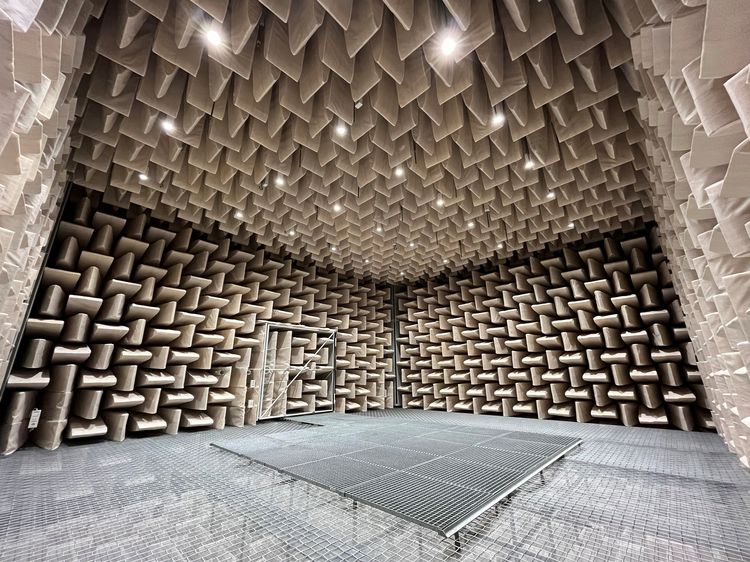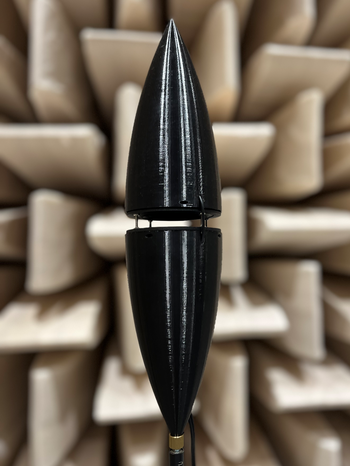Anechoic Lab
Contact
Anechoic Lab
The large anchoic chamber is a room-in-room construction. The absorber wedges (1.5 m long) enable free-field conditions according to the DIN EN ISO 3745:2017-10 standard. The usable space between the absorber wedges above the cable grid is 8.50 x 7.00 x 4.00 m3 (238 m3). The inner room is supported by metal springs and thereby isolated from the outer environment, providing vibration insulation against frequencies higher than 5 Hz. The background noise level inside the room is well below the absolute threshold of hearing even with the ventilation system running. Equipment for multichannel playback and recording of sound is available.
The anechoic chamber is mainly used for two different types of measurements: psychoacoustical tests and characterization of sound sources and receivers.
Listening tests: Sound localisation
Apart from a more "technical" use of the anechoic chamber, it is suited to various listening tests for investigating human perception and ratings of sound. This is not limited to plackback with one or two speakers at a fixed location, but facilities are provided for source positioning and multichannel playback.
The picture shows a horizontal semicircle with 31 loudspeakers allowing for simultaneous playback of sound from different positions. The loudspeakers are hidden behind an acoustically transparent curtain and only 180 LEDs, which can be used as visual pointers, are visible for the listener. This rig can be used e.g. for localisation experiments in the horizontal plane.
Measurement of Head-Related Transfer Functions (HRTFs)

The picture shows a vertical loudspeaker array, which is holding 12 small broadband loudspeakers on an arc around a subject or, in this case, a dummy head. It is used for measurements of head-related transfer functions (HRTFs) with a continuous rotation of the subject and an adaptive filtering technique.
Frequency response, directivity pattern and sound power
A "classic" use of an anechoic chamber is the characterization of sound sources and receivers, be it transducers (loudspeaker, microphones) or machinery.
Apart from the frequency response / spectrum of sources, the directivity pattern can be measured with help of a Bruel & Kjaer Type 9640 turntable system or a Portland Tool & Die MDT-4000 (max. load of 100 kg) .
Source power is determined by measuring the sound pressure level or, preferably, the sound intensity on a closed surface around the equipment under test.
An example of a frequency response and directivity pattern measurement is shown. The source was an OmniSource developed in our group, a (mostly) omnidirectional speaker for room acoustics purposes. The frequency response was measured on axis and the directivity pattern from tip to tip. The source has a limited (150 Hz - 10 kHz) frequency range and a highly irregular frequency response with some resonances. Without an equalization, this is not a speaker for music playback. But the directivity is, even at 10 kHz, mostly omnidirectional. This means that the frequency responce is nearly direction independent, making an equalization with a filter possible.
R. Kruse, A.Häußler, S. van de Par (2013) An omnidirectional loudspeaker based on a ring-radiator. Applied Acoustics 74(12), 1374-1377. doi.org/10.1016/j.apacoust.2013.04.018





